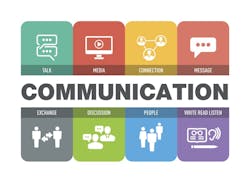Something that is getting lost in today’s world of smartphones and social media is the ability to successfully communicate with others. It is this ability — more than any other factor — that will determine your job security and career opportunities.
Generally, we say a communication is successful if it achieves a useful goal. For example, you accurately describe a problem so another person also understands. On the other hand, miscommunication can have unpleasant consequences.
For example, people often misuse words, because they don’t take the time to know what those words actually mean. In the electrical arena, setting aside time to study the words and definitions in Art. 100 of the National Electrical Code (NEC) is a basic prevention measure; are you doing this now? If not, what kinds of failures are you setting yourself up for?
Okay, so if clear communication depends upon correct word usage, what else aids communication?
Respect is another factor. In social media, insulting other people is common. What is the effect of this when you are trying to persuade people? Rather than win a disagreement (a win is when both sides come to agreement), an insult merely makes the disagreement less pleasant. It doesn’t add any information that supports either side of the point being debated; it just debases the conversation.
If you’re working on a project and a person on the client side asks what seems like a stupid question, how do you respond? You can choose to impress that person with how respectful and knowledgeable you are, or you can leave the impression that you’re a jerk. Which impression provides more benefit? How do you feel toward a company whose representative treats you rudely?
In a less obvious situation, a client may question your competence. You could take this as a personal insult and respond in kind, or you can put yourself in the client’s shoes and understand that this person just wants reassurance that you know what you’re doing. You can say something like, “That’s a great question, and I’m glad you asked it,” then provide the facts that support the question behind that question.
Take your interpersonal communication skills seriously, and work on them. Observe how people you like or respect talk to other people. How do they talk to you? Do you feel understood? Respected? Valued? Why do you feel that way, and what is it about how those people communicate that provides that outcome?
Here’s one final tip. We all make mistakes, such as not fully listening to people, jumping to conclusions, or snapping at someone. A genuine apology after a communication mistake can work wonders. An apology is not a sign of weakness. It is an act of strength.
About the Author

Mark Lamendola
Mark is an expert in maintenance management, having racked up an impressive track record during his time working in the field. He also has extensive knowledge of, and practical expertise with, the National Electrical Code (NEC). Through his consulting business, he provides articles and training materials on electrical topics, specializing in making difficult subjects easy to understand and focusing on the practical aspects of electrical work.
Prior to starting his own business, Mark served as the Technical Editor on EC&M for six years, worked three years in nuclear maintenance, six years as a contract project engineer/project manager, three years as a systems engineer, and three years in plant maintenance management.
Mark earned an AAS degree from Rock Valley College, a BSEET from Columbia Pacific University, and an MBA from Lake Erie College. He’s also completed several related certifications over the years and even was formerly licensed as a Master Electrician. He is a Senior Member of the IEEE and past Chairman of the Kansas City Chapters of both the IEEE and the IEEE Computer Society. Mark also served as the program director for, a board member of, and webmaster of, the Midwest Chapter of the 7x24 Exchange. He has also held memberships with the following organizations: NETA, NFPA, International Association of Webmasters, and Institute of Certified Professional Managers.
